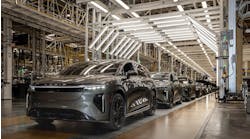Best Practices -- Cost Accounting Undercuts Lean
Lean manufacturing generally is regarded as a good thing. But when lean fails to integrate accounting, the result can be management reporting that fails to reflect operations improvements and negatively represents lean results. That's not a good thing. Two finance executives who have helped lead lean organizations say it's possible to bridge the operations and accounting worlds and create lean-reflective financials by getting accounting involved in lean initiatives, replacing standard cost-accounting with simpler management reporting and adopting valued-added accounting practices. "The first thing that needs to change in terms of a company's movement toward lean is that the finance executive, the CFO or the controller needs to actually, physically, personally participate in the first kaizen events," says Jean Cunningham, vice president and CFO of Louisville, Ky.-based Lantech Inc., a maker of stretch-wrap packaging machines. "They see first-hand that there is real waste being eliminated in the organization -- the waste of time, excess inventory [and] excess activities on the shop floor. Once they see and feel that at some visceral, gut level, they're going to want to make sure that the benefit of that activity is recognizable in their financial statements." In order to make lean recognizable, management reporting needs to move away from cost accounting, which evolved to measure profitability across a range of products and to satisfy generally accepted accounting principles (GAAP) and the Internal Revenue Service. For example, in a batch-and-queue manufacturer, cost accounting tracks inventory transactions as large batches of material creep from process to process. It identifies the value added to material and attempts to quantify, using time studies and budgeted rates, how much labor and overhead should be absorbed into the financial statement, recording unfavorable variances when production is underutilized. Operations, in response, frequently overproduce, one of the "seven deadly wastes" that lean trys to eliminate. In contrast, as a company gets lean, it produces only to customer demand. Cells complete all product processes, cycle times are minutes and inventory is slashed to the quantities moving within cells and quickly to customers. Complex tracking and valuation mechanisms are no longer necessary. "Although you have an inventory valuation that needs to take place [for GAAP], you can do it in a much simpler way," says Orest Fiume, recently retired vice president of finance for the Wiremold Co., West Hartford, Conn. The lean wire and cable manufacturer reduced its inventory from four months to less than four weeks over about four years. Tracking transactions isn't needed, says Fiume. "Once you get to lean, those transactions become waste." Transition Trauma Cost accounting is especially problematic for lean during the financial periods when inventory is being reduced. In a cost-based system, inventory represents, in addition to its material content, "labor and overhead that you incurred to produce the product that you're capitalizing on your balance sheet and deferring the recognition of until some future period when you sell the inventory," points out Fiume. "When you go from four months of inventory to three weeks of inventory, all those deferred costs have to come off the balance sheet. There is only one place for those deferred costs to go, and that's through the profit-and-loss [P&L] statement, generally showing up as unfavorable overhead variances." This negative impact (see Lean Transition: Profits Down, Cash Improved) alarms unknowing executives, who then question lean initiatives. "I think that's why a lot of public companies have a hard time achieving significant success [with lean], because there is so much emphasis on earnings per share; they don't have the tolerance for this," says Fiume. To add insult to injury, cost accounting doesn't clearly show the tangible benefits of lean strategies: improved cash flow, freed-up capacity and reduced floor space. "From a management perspective, a standard-cost P&L is virtually useless," adds Fiume. "It's not actionable and gives you information that is old and in most cases misleading." Cunningham says lean companies should create simple-to-read statements that identify "natural" expenses, such as labor, scrap and utilities. "I have a financial statement for the company's results for every product line on the first day of the month, every month. I've got current information that people understand how to read that can help the organization know how we're doing and what's coming forward." Fiume says shareholders and others reading statements need to be educated. Public companies should focus on analysts that cover the company's stock as their first audience because "if they don't understand it, they're not going to be able to report it properly in their analytical reports." Value-Add Accounting As companies get lean they also reduce material order sizes and increase the frequency of material deliveries. Traditional accounting becomes swamped as it matches packing slips, purchase orders and invoices before paying vendors. Cunningham says accountants instead should focus on three essentials of material procurement: agree on the price to pay vendors for parts, get vendors to deliver parts on time, and then pay vendors. "We found that the cost to control the paper transfer was higher than the cost of the risk that we were incurring by not doing it that way." Reduced tracking and bill-paying activities opens up value-adding opportunities for accounting, such as analysis and consulting. While Lantech has increased inventory turns from four to 10 and more than doubled sales from the same square footage, its accounting staff has shrunk, says Cunningham, and many outsourced activities, such as tax preparation, were brought in-house. "We have improved profitability dramatically, we have improved flexibility, we have more new products being developed, and we have more cash than we've ever had," she says. "There is no question in my mind that it's because we not only have become a lean manufacturer, we've become lean accountants, lean order management [and] lean engineers."



